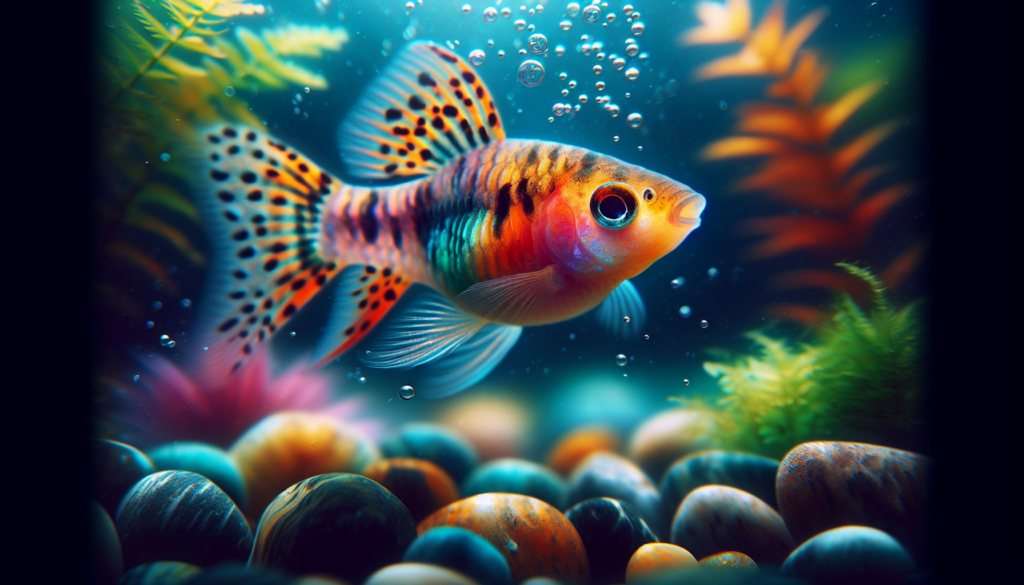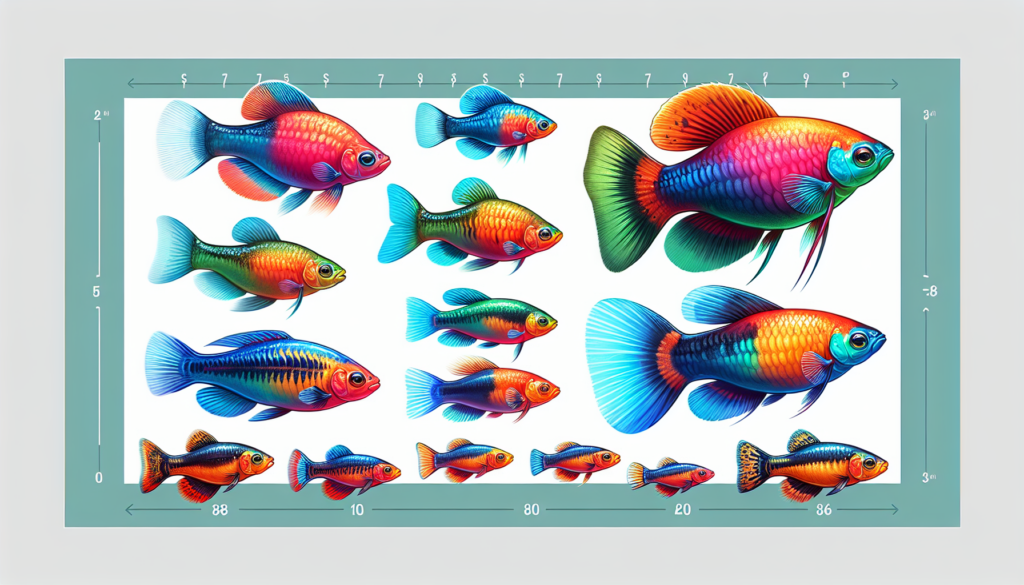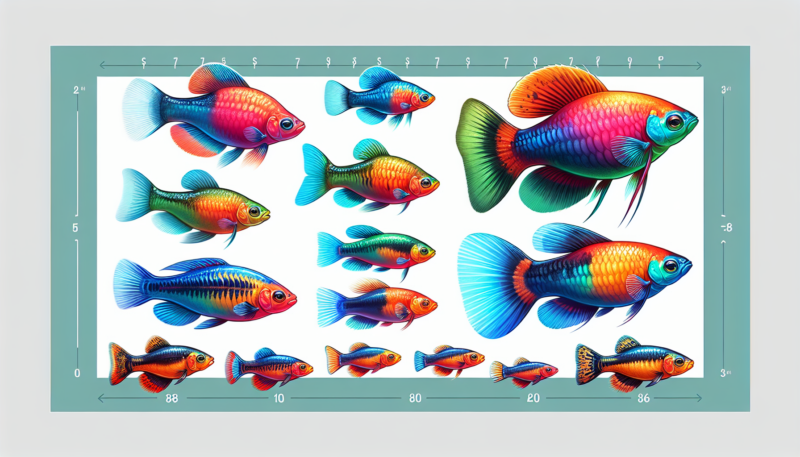Have you ever wondered how big platies, those playful and colorful fish, can actually get? Well, you’re in luck! In this article, we will explore the average size of platies, shedding light on their growth potential and giving you a better understanding of these aquatic creatures. So, get ready to dive into the fascinating world of platies and discover just how big they can become!

What is the average size of platies?
Introduction
Platies are small freshwater fish that are commonly kept in home aquariums. They are known for their vibrant colors and peaceful nature. If you’re considering adding platies to your aquarium, you may be wondering about their average size. In this article, we will delve into the factors that influence the size of platies, the typical sizes of common varieties, and how to recognize a healthy size. We will also compare the sizes of platies with other livebearer fish species. So, let’s dive in and explore the world of platy sizes!
1. Overview of Platies
1.1 Description
Platies are generally small-sized fish, characterized by their round bodies and unique colors. They have a short, triangular-shaped head and a small mouth. The average length of adult platies ranges from 1.5 to 2.5 inches, with females usually being larger than males. Their bodies come in various colors and patterns, making them a popular choice among aquarium enthusiasts.
1.2 Habitat
Platies are native to the freshwater rivers and streams of Central America, particularly Mexico. They thrive in warm water conditions with temperatures ranging from 72 to 82 degrees Fahrenheit. In the wild, they are often found in shady areas with plenty of vegetation. When designing their aquarium habitat, it is essential to provide them with ample hiding spaces and dense aquatic plants.
1.3 Lifespan
On average, the lifespan of a platy ranges from 2 to 3 years. However, with proper care and optimal living conditions, platies can live up to 5 years. Factors such as genetics, diet, water quality, and stress levels can influence their lifespan.
2. Factors Influencing Platies’ Size
2.1 Genetic Variation
Just like any other living organism, the size of platies is determined partly by their genetic makeup. Different varieties of platies have been selectively bred over the years, resulting in variations in size. While some strains tend to be smaller, others can grow larger. It is important to note that genetic factors alone cannot solely determine the size of an individual platy, as other external factors play a significant role.
2.2 Nutrition and Feeding
Proper nutrition is crucial for the healthy growth and development of platies. A well-balanced diet consisting of high-quality fish flakes, pellets, and occasional live or frozen foods will support their growth. Over and underfeeding can have negative effects on their size. Providing adequate amounts of food and ensuring a varied diet will help maintain optimal size and overall health.
2.3 Tank Size
The size of the tank in which platies are kept can directly affect their growth. A smaller tank might restrict the fish’s movement and limit its growth potential. As a general guideline, it is recommended to provide at least 5 gallons of water per platy to allow for adequate swimming space and growth.
2.4 Water Quality
Maintaining optimal water quality is essential for the health and growth of platies. Poor water conditions can stress the fish, leading to stunted growth. Regular water changes, proper filtration, and monitoring of water parameters such as temperature, pH, and ammonia levels are necessary to promote healthy growth.

3. Typical Sizes of Common Platies
3.1 Red Wagtail Platy
The Red Wagtail Platy, also known as Xiphophorus maculatus, is one of the most popular varieties of platies. They typically grow to be around 2 to 2.5 inches in length. Females tend to be slightly larger than males and can reach up to 2.5 inches. The vibrant red coloration with black tails makes them a visually striking addition to any aquarium.
3.2 Mickey Mouse Platy
Mickey Mouse Platies, scientifically known as Xiphophorus maculatus, are named after the distinctive spot on their caudal fin that resembles Mickey Mouse’s silhouette. These platies usually grow to be around 1.5 to 2 inches in length. While males are generally smaller, females can reach up to 2 inches. Their small size and playful patterns make them a popular choice among aquarists.
3.3 Sunset Variatus Platy
Sunset Variatus Platies, scientifically known as Xiphophorus variatus, are a colorful variety that adds a vibrant touch to any aquarium. These platies typically grow to be around 2 to 2.5 inches in length. Females are slightly larger than males and can reach up to 2.5 inches. With their orange, black, and yellow coloration, Sunset Variatus Platies are a stunning addition to a community tank.
4. Growth Rate of Platies
4.1 Factors Affecting Growth Rate
Several factors influence the growth rate of platies. As previously mentioned, genetics, nutrition, tank size, and water quality are crucial factors. A nutritious diet that provides essential proteins and vitamins promotes healthy growth. Ample swimming space, provided by a spacious tank, allows the fish to exercise, resulting in proper muscular and skeletal development.
4.2 Growth Spurts
Platies, like many other fish species, experience growth spurts during their development. These growth spurts occur during their early stages of life and can vary in intensity and duration. Providing optimal living conditions, including suitable tank size and water quality, during these growth spurts is crucial to ensure proper growth.
5. Male vs. Female Platies
5.1 Size Differences
In most cases, female platies are larger than males. Females can grow up to 2.5 inches in length, while males tend to reach around 2 inches. This size difference can be more pronounced in certain varieties of platies. It’s important to consider these differences when selecting platies for your aquarium, as it can affect the overall balance and aesthetics of the tank.
5.2 Sexual Dimorphism
Apart from size, male and female platies also exhibit distinct physical characteristics known as sexual dimorphism. Males have a modified anal fin, called a gonopodium, which is used for mating. Females, on the other hand, have a rounded, fan-shaped anal fin. These differences in their reproductive organs help distinguish between the sexes.
6. Recognizing Healthy Sizes
6.1 Body Proportions
Recognizing a healthy size in platies involves assessing their body proportions. A healthy platy should have a well-rounded body with no signs of bony deformities or malnutrition. Their body should appear plump and symmetrical. If a platy appears emaciated or disproportionally elongated, it may indicate underlying health issues.
6.2 Fins and Tail Size
The fins and tail of a platy can also indicate its overall health and size. A healthy platy will have fins that are fully extended and not clamped against its body. The tail should be intact, without any tears or fraying. If a platy’s finnage appears tattered or its tail is significantly smaller than normal, it may be a sign of poor health or improper growth.
7. Comparison with Other Livebearer Fish Species
7.1 Guppies
Guppies are another popular livebearer fish species often compared to platies. In terms of size, platies and guppies are quite similar. The average size of guppies ranges from 1.5 to 2.5 inches, making them comparable to platies. However, guppies are known for their extravagant tail fins, which can sometimes extend beyond their body length.
7.2 Swordtails
Swordtails, belonging to the same family as platies, are often larger in size. On average, swordtails can grow up to 4 inches, making them significantly larger than platies. Their name comes from the elongated lower part of their tails, which resembles a sword. Swordtails are a visually striking fish species that can add a unique touch to an aquarium.
10. Conclusion
In conclusion, the average size of platies ranges from 1.5 to 2.5 inches, with females usually being larger than males. Genetic variation, nutrition, tank size, and water quality are all factors that influence the size and growth rate of platies. By providing optimal care and maintaining a balanced environment, you can ensure that your platies reach their full potential size and live a healthy life. Always remember to carefully observe the body proportions and finnage of your platies to recognize any signs of health issues. Whether you choose platies, guppies, or swordtails, these livebearer fish species will bring color and joy to your aquarium. So, get ready to enjoy the beauty and charm of these delightful fish!
